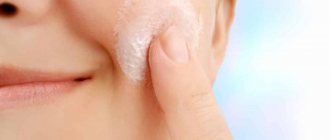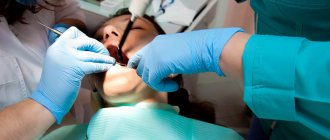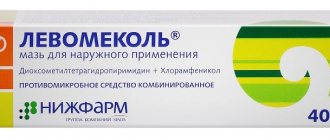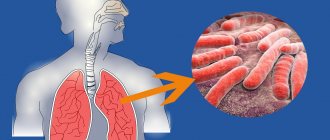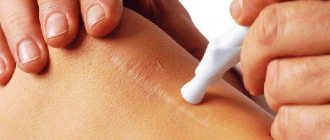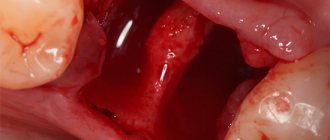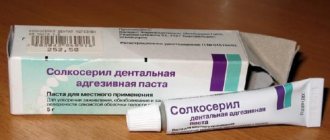Acne is a disease that appears for a variety of reasons. The main symptom of the disease is the appearance in different places of the skin of inflamed nodules - pimples or pustules, inside of which there is liquid. It could be blood, pus, just clear liquid and other options. It is called exudate.
The clear liquid most often found inside a pimple is also exudate. It occurs as a result of the inflammatory process and due to the influence of several factors.
What kind of clear liquid flows out when you press on a pimple?
Blackheads most often appear as small bumps on the skin. Inside them is a light or white liquid. If there is a cloudy tint, this indicates that there is severe inflammation inside and bacteria, which are commonly called pyogenic, are “working” here.
The clear liquid inside such a pimple always contains fibrin (coagulated protein), serum and dead white blood cells. The absence of color, that is, the transparency of such a liquid, does not at all mean that the person does not have an inflammation process.
Rashes on the body can be of very different sizes. The reasons for their appearance are also different. Some of them can be quickly treated, while others can appear on the skin several times a year throughout life. This condition is called relapse.
Therefore, the elimination of acne, pimples and other inflamed nodules on the skin should be carried out only by a dermatologist or infectious disease specialist after making an accurate diagnosis.
Causes of the rash
Most often, acne on the hands and body appears for a short period of time and is allergic in nature. As soon as contact with the allergen ends, the pimples disappear. Such papules have shades of pink, blue or yellow.
But rashes can also occur due to a bacterial or viral infection. The most common causes of rash are the following conditions:
- hives;
- chickenpox;
- prickly heat;
- sunburn;
- shingles;
- eczema or mycosis;
- herpes;
- scabies;
- dyshidrosis
Vesicles can also appear as a result of hormonal imbalance. Women often face this problem during pregnancy. And if in some cases it is quite easy to determine the cause of rashes on the body, then there are situations in which tests and consultation with a specialist cannot be avoided.
Causes of pimples with clear liquid inside
It is quite difficult for a non-specialist to name the exact cause of the appearance of such rashes. This could be a decrease in immunity, skin infection, or an allergic reaction. All these factors most often become the main provocateurs of watery acne. They can appear at any age on any part of the body - on the face, wrist, neck, even scalp, back, legs.
They increase in size, are very itchy and itchy, or may not cause any inconvenience at all and go away on their own within 3–4 days from their appearance.
The reasons for the appearance of watery acne on the skin of the human body are different. But still, most often this unpleasant condition is observed when:
- Allergic reaction.
- Hormonal imbalance.
- Dyshidrotic eczema.
- Viral infections.
- Damage to the epidermis by streptococcus.
- Skin infection with staphylococcus.
- Chicken pox.
For some diseases, large or small pimples with watery fluid inside are the main symptom that helps to quickly make an accurate diagnosis and prescribe the correct treatment to a specialist.
Watery pimples on the face
Various types of rashes on the face are often caused by hormonal imbalances and disruption of the sebaceous glands.
The pathogenesis of watery acne is based on dysfunction of the sweat glands, which develops for the following reasons:
- Hormonal imbalances. In women, acne with exudate develops due to menstrual irregularities, during pregnancy, or when taking oral contraceptives.
- Impact of physical factors. Pathological changes on the face are observed when exposed to sunlight or frostbite.
- Infections . With herpes, blisters are observed on the lips and around the wings of the nose. Chicken pox is characterized by the appearance on the face of bullae - blisters more than 5 mm and vesicles - pustules less than 5 mm.
- Influence of chemical components. The use of low-quality cosmetics contributes to clogging of the excretory ducts and the formation of serous acne.
With allergies, pathological elements on the face are also observed. It is important to carry out a differential diagnosis of allergies. Only a doctor can do this.
Allergic dermatitis
This is an inflammatory disease of the epidermis, which is based on a local allergic reaction. It manifests itself as swelling, itching, redness and the appearance of pustules in the form of bubbles containing transparent or cloudy contents. This rash is not dangerous and does not pose a danger to others. However, it causes a lot of trouble for the patient himself.
This is what pimples with liquid content look like in allergic dermatitis
Allergic dermatitis is an abnormal reaction of the immune system to an irritant (allergen) that affects the skin. For some, unpleasant symptoms appear at the first contact. For others, only after numerous repeated exposures to the same substance.
The following components most often act as allergens:
- Washing powder.
- Any household chemicals.
- Perfumes and cosmetics.
- Synthetic materials.
- Dyes used in the manufacture of fabrics.
- Plant pollen.
- Household dust.
- Some medications applied to the skin - ointments, creams, gels, patches, rubbing.
After eliminating contact with the irritant, the watery allergic rash goes away on its own without any consequences.
Simple rules before using medications
Before you start treatment with any means, remember these simple rules:
- Clean the surface of the skin from makeup and dirt with your usual cosmetic products.
- Steam your face over a steam bath. To do this, you can use decoctions of medicinal herbs such as chamomile, sage, etc.
- After the procedure, wash your face with cool water and pat your face dry with a soft towel.
How to quickly get rid of an internal pimple with medications?
Currently, on the shelves of stores and pharmacies you can find a huge number of remedies for inflammation of the skin. Many people do it simply: they buy several products at random and look for what will help better and faster. But such searches can negatively affect your health and only worsen the situation. Each person has their own characteristics of the dermis, so one lotion or gel helps someone, another helps someone, etc. A dermatologist will help you find out what is right for you based on a study of the inflammatory process and the tests you have taken.
So, here’s what people use and save themselves from internal acne:
- Skinoren is a cream based on azelaic acid, which has anti-inflammatory and antibacterial effects.
- Levomekol is an ointment that has antimicrobial and anti-inflammatory effects.
- Ichthyol ointment is an anti-inflammatory, antiseptic and analgesic.
- Zinc ointment is an anti-inflammatory, drying, adsorbent, antiseptic agent.
- Vishnevsky ointment is an antiseptic, healing agent that can quickly and effectively “draw out” pus and get rid of bacteria.
- Doxycycline is an antibiotic of the tetracycline group with a bacteriostatic effect, prescribed by a doctor in the most complex inflammatory situations.
- Roaccutane is also used in more severe forms of rashes. It is a derivative of retinoic acid, which blocks the secretion of the sebaceous glands, dries out the skin, thereby depriving the pathogenic area of “food”.
Thus, these ointments and creams, which have an anti-inflammatory effect and can “pull” pus out, will help speed up the maturation of painful pimples.
Hormonal changes or disturbances
Rashes caused by hormonal imbalances most often develop in adolescence, when the body undergoes restructuring. The main localization is the forehead, nose and chin. Such acne is difficult to treat, since its cause lies inside the body. And no doctor will interfere with a person’s hormonal system at this age.
Pimple like a lump with contents inside
In addition to the teenage transition period, hormonal acne with liquid contents inside can appear for other reasons, which include:
- Poor nutrition.
- Mono-diets.
- Constant stressful situations.
- Taking contraceptive medications.
- Pregnancy.
- Disturbances in the functioning of the ovaries, which may be associated with their disease or with age-related changes.
- Obesity.
- Diabetes.
Hormonal imbalances are a serious pathology that requires mandatory consultation and treatment only from a specialist. Moreover, this will no longer be a dermatologist, but an endocrinologist.
Colds and skin diseases
Watery pimples are often localized on the face; the nose and lips are most often affected. Similar manifestations are typical for herpes, which is transmitted through household and sexual contact. This is a common virus that is activated when immunity decreases. A decrease in the body's protective properties can cause a cold. Therefore, watery pimples on the face, as a sign of herpes, are often called a cold. Therapy in this case requires an integrated approach.
Another type of herpes also causes blistering rashes, these are manifestations of herpes zoster. It is accompanied by severe pain and disturbances in the functioning of the nervous system.
Blisters may appear on the lips, and they are very itchy
Waterpox is characterized by papules. Based on this sign, the disease is easy to diagnose. With chickenpox, the rash is initially localized in the abdomen, lower limbs and hands. Then they spread throughout the body. Therapy consists of the use of antipyretics. And pimples with liquid inside are treated with brilliant green. If the watery rashes on the body are the result of an infection with scabies mites, they are very itchy. You need to make an appointment with a dermatologist.
Dyshidrotic eczema
An unpleasant skin disease that is chronic and often worsens. The main symptom is the appearance of a large number of small blisters with serous contents inside.
Symptoms of dyshidrotic eczema on the fingers
It can occur at any age with equal frequency in men and women. It is not yet known for what exact reasons the symptoms occur. However, provoking factors may include:
- Increased sweating.
- Food allergies.
- Hereditary predisposition or family history of seasonal fever and atopic dermatitis.
- Overweight.
The disease begins with severe itching, mainly localized on the fingers. Areas of redness appear. Then small bubbles called vesicles appear here. Their number may vary. They all contain liquid inside. And their shell is quite dense.
Gradually, the rashes merge into one large group, and then burst with the formation of erosions. Due to the unbearable itching, the patient tries to scratch the skin harder, which provokes the onset of the inflammatory process.
Gradually, the erosions heal, crusts appear on them, fall off and leave no traces behind.
Symptoms
When a patient complains of strange pimples, this does not mean that they are actually special. It’s just that a person has never encountered such rashes before and considers them something incomprehensible. This may apply to acne with the following characteristics:
- Which are not squeezed out, but remain under the skin.
- With serous contents (clear liquid).
- Accompanied by the formation of erosions and ulcers (“wounds” or “sores”).
- They are localized not only on the face, but also on other parts of the body.
- They cannot be cured on their own.
If something in the development of acne goes beyond what a particular patient would expect, he may call it strange. But to the doctor, the rash will not appear as such, since he knows the probable variants.
Acne
When sebum production is disrupted and follicular canals become keratinized, acne (blackheads) develops. They may be of the following nature:
- Open or closed comedones.
- Papules (small nodules).
- Pustules (with a purulent core).
- Dense subcutaneous nodes.
First, when there is only a blockage of the excretory ducts of the sebaceous glands, comedones are formed. They are called open when the plug is located near the surface and is easily removed. Closed comedones often take on the appearance of blackheads, and when squeezed out of the pore, the thick sebum clogged there (pimple core) comes out.
The addition of an infection leads to the development of inflammation - then comedones turn into all other elements (papules, pustules, nodes). Often acne can merge with each other, forming dense conglomerates with a bumpy surface. Microabscesses sometimes form in the center of some acne, which heal with scarring once opened.
Acne is a fairly common phenomenon that many young people experience.
Milia
If the pimple is difficult to squeeze out and looks like a small millet-like white nodule, then most likely it is milia. Many such rashes are called millet. In most cases, the elements are located around the eyes and on the cheeks. Milia are accumulations of keratin in the surface layer of the skin, that is, they are peculiar small cysts.
It is very difficult to squeeze out these pimples, but if you succeed, what comes out is not a thick mass in the form of a rod, but a small amount of white soft substance. In addition, rashes disappear on their own during the process of natural skin renewal, which once again distinguishes them from comedones.
Pyoderma
Pyoderma involves an inflammatory process with the formation of pus. If it is of staphylococcal origin, it is characterized by damage to the hair follicle, ducts of the sebaceous and sweat glands. In this case, the element (pustule) has a conical shape with infiltration at the base. When opened, thick yellow-green pus comes out, and in the center there is vellus hair.
Streptococcal pyoderma is accompanied mainly by superficial skin lesions. Flat blisters with a flabby tire (phlyctena) are formed, and their contents are serous-purulent in nature. Such elements are prone to peripheral growth and fusion.
Herpes simplex
Another example of acne that does not fit into the patient’s usual understanding is herpetic eruptions. And although they occur in many people (the rate of infection of the population with the virus is almost 95%), not everyone understands how herpes simplex manifests itself.
First, at the site of future elements - mainly on the lip or nose - itching and burning appear. Soon bubbles appear there, filled with serous contents resembling water. The vesicles burst and transform into superficial erosions, which become crusted.
With herpes simplex, the vesicle turns into erosion, which becomes covered with a crust and heals without a trace.
Allergic diathesis
Strange pimples of an allergic nature also occur. In children they have the form of diathesis, and in adults we are talking about neurodermatitis and atopic dermatitis. Elements on the skin of the face are distinguished by polymorphism: spots, papules, vesicles. In children, typical lesions are located on the cheeks and are accompanied by weeping and peeling. At this time, fatty yellowish scales (gneiss) form on the scalp.
In adults, the body's sensitization to the allergen is more pronounced. Characterized by redness, swelling of the skin, papules and vesicles. All this is accompanied by severe itching, which causes scratching and may result in a secondary infection (pyoderma). In neurodermatitis, the lesions are located predominantly on the flexor surfaces and are accompanied by increased skin pattern and peeling.
Demodicosis
If a Demodex mite has settled in the skin, strange rashes may appear on the face. Conventional anti-acne medications do not have an effect; instead, acne spreads more strongly and sebum secretion increases. If red dots and papules appear first, then later they turn into pustules. Often the eyelids are affected, where inflammation occurs (blepharitis) and eyelashes fall out.
Herpetic viral infection
A common disease with frequent relapses caused by the herpes virus - HSV-1, HVS-2. In this case, the skin around the mouth, nose, as well as the mucous membrane of the mouth, eyeballs and genitals are damaged.
Vial with transparent contents for herpetic infection
The transmission mechanism for diseases is different. For example, the herpes virus, which is called HSV-1, is most often transmitted from a sick person to a healthy person through contact and household contact through the use of shared utensils, linen, and other hygiene items. The second most common transmission route is airborne droplets, and the third is airborne dust.
HVS-2 is transmitted primarily through sexual contact.
The herpes virus that has entered the body remains without symptoms for a long time and does not cause disease. But as soon as hypothermia occurs, immunity decreases and the first symptoms begin. This is the appearance of pimples on the skin that are very itchy and contain cloudy or clear liquid inside.
It is not recommended to comb them, since in addition to liquid they contain a huge amount of viruses, which, once on healthy skin, cause the appearance of new rashes.
Possible causes of watery pimples
Pimples with liquid inside can be symptoms of various diseases, which only a doctor can reliably determine.
This is what small watery pimples on the body look like
For example, they may indicate the presence of prickly heat or allergic dermatitis. Since a rash of any nature indicates a malfunction of any body system, water formations should also not be excluded from the list of such “telling” symptoms. With prickly heat, the rashes are localized on the bends of the limbs and on the abdomen. Allergic dermatitis can be observed on various parts of the body, and rashes can spread throughout the body. Therefore, in order not to aggravate the condition, it is impossible to press, rip off or have any other mechanical impact on such pimples.
Watery pimples on the face are often symptoms of herpes, dyshidrosis or molluscum contagiosum. Their appearance in the circumlabial area often indicates the activation of the herpes virus in the body. There is no point in fighting such symptoms if you do not fight the virus itself. To combat a herpes infection, special treatment prescribed by a doctor is required.
If rashes filled with clear liquid appear, then the cause may be an infectious disease such as molluscum contagiosum. In this case, watery pimples cover the fingers. With infectious dyshidrosis, they can be observed in various parts of the body. Given these circumstances, it is impossible to determine which disease causes the rash without a thorough medical examination.
In children, water pimples are mainly a symptom of chickenpox (chickenpox). As you know, the disease has almost no consequences for a child. Adults who had chickenpox as children need not worry. However, if an adult gets chickenpox for the first time, it is advisable to consult a doctor. This precaution is explained by the fact that the older a person is, the more severely he suffers from chickenpox. There are even cases of death.
Experts explain the appearance of watery pimples all over the body or in a specific place by an unfavorable combination of the state of the body and the influence of external causes on it. So, for example, they can be observed in allergies to animal fluff and hair, food, medications, dust, flowering plants. Rashes of this nature can also be triggered by unfavorable weather conditions. Especially irritants from the environment “help” the internal state of the body to manifest negative symptoms in the form of watery rashes in the following cases: with impaired functioning of the thyroid gland, with diseases of the gastrointestinal tract, with diabetes.
In addition, there are people with a genetic predisposition to similar body reactions to external influences. The combination of external irritants and the resulting psycho-emotional trauma also provokes the formation of a rash with liquid. As you know, stressful situations often lead to the activation of various diseases. Therefore, they can also cause the described symptom.
If small pimples form on the forearms or hands of an adult, then this is most likely idiopathic eczema. With this disease in children, rashes can be observed on the face, arms, legs and buttocks. They itch quite strongly, burst after a short time, after which crusts form. In any of the described cases, you should not wait until the rash goes away on its own, because it can be a symptom of a serious pathology. Self-medication is not recommended; the best option is to see a doctor.
Streptoderma
A skin disease caused by streptococcus. In this case, rather large bubbles appear on the skin without pus, but with a large content of this microbe. Most often, the pathology is diagnosed in children and people with thin and delicate skin.
The main symptom of streptoderma is vesicles with thin skin and clear liquid inside.
Doctors call the following conditions provoking factors:
- A person lacks immunity to bacteria of the genus Streptococcus and when they enter the body they easily cause disease.
- Violation of the barrier function of the skin - scratches, wounds, abrasions, burns.
- The use of drugs that reduce immunity - cytostatics, immunosuppressants.
- Diseases of the endocrine system.
The inflammatory process, which results in redness and severe itching, is the result of the body’s defenses, which try to make a person understand that not everything is okay with the skin.
Treatment of watery rashes
As soon as watery pimples are discovered, you need to rush to the hospital. If you try to dry them using a solution of manganese or some other folk remedies, you can only cause harm to yourself. In some cases, with this effect, small pimples increase in size and form large blisters filled with liquid. At the same time, the area of their localization increases.
First of all, the specialist determines the cause of the rash. To do this, he prescribes various tests. Based on their results, the doctor prescribes the necessary treatment. Watery pimples, depending on the cause of their formation, can be treated with a variety of ointments and tablets. In most cases, a special diet and proper lifestyle are required. Regarding nutrition, you should know that vegetables and fruits are healthy, and smoked and fried foods are harmful under these circumstances.
Clear pimples may be the result of an allergy. If the doctor confirms this, then antihistamines are prescribed for treatment.
If transparent formations on the skin are a symptom of prickly heat, then it is recommended to pay special attention to clothing. So, the fabrics from which it is made must have a light and breathable structure. This rule must be observed especially during the hot season. To avoid heat rash, experts advise keeping large areas of the body exposed. Constantly wearing jeans can cause the rash to spread over almost the entire body area.
If the cause of watery rashes is allergic reactions, a different treatment is selected. Since pimples often itch, to reduce the unpleasant sensations of itching and burning, patients are prescribed antihistamines, valerian tincture and vitamins. Of the ointments, those that contain an antibiotic and a corticosteroid are recommended. This could be, for example, Hyoxysone ointment. You can also combat itchy rashes with cold lotions or compresses with tannin.
Water pimples on the face and body can also appear in pregnant women. As a result of the restructuring of the body, a decrease in immunity occurs, which in turn leads to complex forms of toxicosis, one of the manifestations of which are bubbles with liquid. They cause a lot of inconvenience: they itch, impair sleep, and make women irritable. You can get rid of these dermatoses by taking probiotics and sorbents. Diet is required.
The majority of ointments recommended for getting rid of fluid blisters contain antibiotics and corticosteroids. They are able to suppress various allergic reactions well. In addition, they relieve inflammation, reduce irritation, relieve itching and pain. Such ointments include Fenistil, Elokom, Advantan, Sinaflan, Deperzolon, Lorinden S, Flucinar. However, it should be remembered that these drugs are hormonal and therefore may cause side effects.
Is it possible to open pimples with watery contents inside?
Acne caused by the above reasons, and containing liquid inside, causes discomfort in a person and a desire to get rid of them faster. However, opening such rashes on your own is not advisable and can lead to unpleasant complications.
Firstly, when any bubble is pierced, the liquid gets onto healthy skin, which leads to the appearance of new rashes. This means that the disease will continue, and treatment will last for several weeks, especially if the acne has serous fluid.
Secondly, puncturing any vesicle can leave a scar, since inflamed skin is very vulnerable and requires careful care and careful handling.
Thirdly, when pressed, part of the contents of such a bubble may not leak out, but penetrate into the deeper layers of the skin and even end up in the blood. This causes a life-threatening condition called sepsis.
Fourthly, any squeezing of blisters on the face or in the head area can cause infection of the brain and death of a person.
What's inside black and white pimples?
Poll: When did your acne appear? (Number of votes: 4295)
I've been suffering all my life
It's been a couple of years now
About a few months
Recently
To vote, click on the desired answer. results
What's inside black and white pimples?
Black and white pimples are clogged inside with the same dead skin cells (which your skin always produces when exposed to acne bacteria) form on the skin, and sebum (an oily substance secreted by tiny glands) is found inside your pores.
Many people think that black pimples are clogged with dirt inside, but that's not true. The difference in color between these two types of pimples is actually due to the effects of oxygen, as the National Institutes of Health explains.
In whiteheads, the blockage is below the surface of the skin and therefore remains white. But in blackheads, the seal opens when exposed to air. It turns brownish-black when they are exposed to oxygen.
How to treat acne with clear liquid
The appearance of watery pimples on different parts of the body are symptoms of various diseases. In most cases, this is far from acne, but a serious pathology, which should be treated by a dermatologist, infectious disease specialist or therapist. Moreover, medications are prescribed strictly individually, and the period for taking them is agreed upon in advance with a specialist.
The main methods used by doctors in the treatment of watery acne with clear liquid inside can be divided into several groups.
For example, once the cause is identified, it must be urgently eliminated. This primarily concerns contact or allergic dermatitis. Once the cause is eliminated, the symptoms of the disease will disappear on their own.
To eliminate itching and prevent severe scratching, the patient is recommended to use antihistamines in the form of drops (Fenistil) or tablets (Zyrtec, Suprastin, Claritin).
For confirmed herpes infection, antiviral drugs are prescribed, among which acyclovir should be considered the most popular and effective.
Antibiotics are used only if the causative agents of the disease are pyogenic microbes - staphylococci and streptococci, which are sensitive to the action of these drugs.
Antiseptic solutions are used to lubricate the skin, which will prevent germs from bubbles with liquid contents from spreading to healthy skin. The most commonly used are brilliant green, formic alcohol, miramistin, and chlorhexidine.
It is recommended to expose the skin in affected areas to ultraviolet radiation whenever possible.
Treatment of water acne
Therapy for watery pimples involves eliminating the factors that cause their appearance and normalizing the functioning of the sebaceous glands. Since this symptom is characteristic of various diseases, a doctor should identify the true cause. Adequate therapy will not only relieve the pathology, but will also avoid complications and relapses.
An integrated approach is important in treatment. The use of medications will be weakly effective if hygiene rules are not followed and poor diet. In case of any pathologies, the body's resources are depleted; it is necessary to consume minerals and vitamins.
Along with traditional medicine, alternative methods are used, but only after consulting a doctor. A specialist will help you choose the best options that will speed up the recovery process.
Treatment of rashes with folk remedies
The advantage of folk remedies is their accessibility and versatility.
READ ALSO: Wen on the labia: what they look like and methods of removal at home |
They are suitable for use regardless of the cause of the unpleasant symptom.
- Treatment with aloe juice. The plant has a bactericidal, regenerating effect, reduces burning sensation and irritation. Freshly squeezed juice is applied to the affected areas and washed off with water after half an hour.
- Decoctions and infusions of medicinal herbs. Chamomile and calendula suppress the growth of pathogenic flora, cleanse pores, and soothe the dermis. Low concentrations are suitable for young children. Decoctions are used to wipe areas with rashes and added to baths.
- Applications from a decoction of oak bark. A tablespoon of the dry component is poured into 200 ml of hot water. Use the cooled infusion to wipe the areas with the rash.
The remedies are used until the symptoms disappear completely.
Drug therapy for watery acne
The doctor selects the medication based on the cause and clinical picture of the pathology.
Pharmacological therapy may include the following types of medications:
- antihistamines: Suprastin, Zodak;
- antiviral agents: Acyclovir, Famvir;
- antiseptics: Povidone-iodine, Fukortsin;
- antibacterial ointments: Neomycin, Oxytetracycline.
Oral ones are used for severe disease. The course and dosage are determined individually.
Recommendations
You can speed up the healing process and get rid of unpleasant watery rashes, as well as prevent their reappearance with the help of simple and simple tips.
When the first symptoms appear, you should definitely visit a doctor. At the same time, it is not recommended to lubricate pimples with anything beforehand, as this will distort the true picture of the disease and it may not be possible to make an accurate diagnosis.
Before using this or that medicine, as well as traditional medicine, you must obtain permission from the doctor. Self-medication can cause complications and cause the disease to drag on for too long.
You cannot interrupt the prescribed treatment, change the dosage of drugs, the frequency of administration, or change one medicine for another without the consent of a specialist.
Pimples with watery fluid are always a sign of a pathological process or disease. They may appear only once in a lifetime, or they may appear regularly. But even if they do not cause discomfort, they must be treated. And, of course, it is imperative to identify the cause and eliminate it in order to prevent the recurrence of the disease.
Allergy
Various components can be an allergen. This is flowering, dust, animal hair, cosmetics. Watery pimples appear on which part of the body, most likely the allergen affects this part of the skin more. Home care products and washing powders can also act as a provoking factor. Rashes all over the body are characteristic of a food allergen.
The most common causes are prickly heat and allergic dermatitis.
If they appear after contact with cold water or snow, the allergen is cold. This condition should be under the supervision of specialists. Pimples with water inside constantly itch, this indicates a worsening situation. The photo shows what watery pimples on your hands look like.
Types of acne depending on age and gender
Acne has its own characteristics in children, adolescents and adults. In particular, according to localization, acne in adolescents is located mainly in the T-zone (forehead, nose, upper part of the chin), and in adults in the U-zone (cheeks, around the mouth and lower part of the chin). The nature of the rash may also differ. In children and adolescents, comedones are almost always present, while in adult men and women they may be absent or present in small quantities. The inflammatory process is often more pronounced in adults. For more information about what to do if acne appears, read the article: “Acne - what tests to take, which doctor to see.”
Acne in children
1. Newborn acne
. Occurs in the first 3 weeks after birth due to a hormonal crisis caused by the influence of maternal hormones. They are characterized by a rash on the forehead, cheeks, chin in the form of comedones and rarely papules and pustules. Goes away on its own within 2 weeks.
2. Baby acne.
Appears at 6 weeks of age and can last up to 1 year. Boys are more susceptible than girls. Elements are more often on the face in the form of comedones, papules and pustules, nodes are very rare.
3. Acne of middle childhood.
Acne appears after 1 year and up to 7 years. It is very rare and may be a consequence of congenital adrenal hyperplasia, an androgen-producing tumor.
4. Pre-teenage (pre-adolescent) acne.
Acne appears after 7 years of age and indicates early puberty. It mainly affects the T-zone, rashes in the form of comedones, papules and pustules. Even after comedones, scars may remain.
Juvenile acne
With varying degrees of severity, juvenile acne occurs in almost all girls and boys. The first rashes can appear in boys from 12-14 years old, in girls from 11-13 years old. By age 24, acne either regresses or progresses to adult acne. At the age of 11-14 years, the comedonal form of acne predominates, and from 15-17 years, the papulopustular form predominates. After 17 years and up to 24 years, inflammatory forms of acne and nodular cystic acne predominate. Boys have a more severe course than girls.
Acne in adults
Acne in adults can be divided into 3 types:
- Persistent or persistent acne.
It first appears in adolescence and continues into adulthood.
— Late-onset acne.
Appears for the first time after 25 years.
In women, late acne includes premenstrual (2-7 days before) and postmenopausal acne. If late-onset acne appears, the woman should be examined for the presence of polycystic ovary syndrome, ovarian or adrenal tumors.
- Recurrent acne.
Juvenile acne resolved and there was a long period of remission for several years, and then acne reappeared.
There are also other types of acne that occur only in adults:
Acne inversa
occur with secondary damage to the apocrine sweat glands and mechanical impact. Localization - armpits, perineal area, navel, areola of the mammary glands. May be combined with increased body weight. It can occur in severe form with the formation of fistulas and cysts.
Bodybuilding acne
occur most often in men while taking anabolic steroids or when taking androgens. Characterized by the appearance of nodular toxic acne.
Necrotic acne (aspe necrotica)
can occur after 15 years and up to 40 years, have a chronic course. The localization area is the scalp, most often the frontal and frontotemporal areas. It manifests itself as vesiculopustular rashes, which open with the formation of erosion; upon healing, a smallpox-like atrophic scar appears.
Tropical eels (aspe trcpicalis)
occur in older people living in hot, humid climates. They manifest themselves as abscessing conglobate acne. Locations: back and buttocks.
Keloid acne (acne keloidalis)
characteristic of men, the disease lasts a long time and is resolved by sclerosis of the affected areas. Initially, pointed or flat papular rashes of pink color are diagnosed. Location: the back of the head and the border of the scalp.
Acne-tetrada
the most severe form of acne, which includes conglobate, inverse and abscess acne, Hoffmann's folliculitis undermines and complete or incomplete pilonidal sinus (a purulent cavity with a tuft of hair).
Artificial (mechanical)
acne occurs from friction and pressure with a tendency to develop acne. Inflammatory elements are localized in places of friction and compression, often at the border of the scalp and forehead from the cap, under the cast, on the back of the neck.
Cosmetic acne (acne cosmetica)
arise from cosmetic products with comedogenic effects. Fats and oils act as pathological agents: lanolin, petroleum jelly, some vegetable oils, tar. Frequent cases of cosmetic acne have been reported after using tanning oil. The rashes are localized in the areas where these cosmetics are applied.
Tags: acne
Market Analytics
- Black Lives Matter movement: reaction and consequences for the beauty industry
- COVID-19 is changing the rules of the game in the cosmetics market
- Beauty of the future: cosmetic innovations 2020
Convenient search for beauty salons on our website
Beauty salons in Moscow Beauty salons in St. Petersburg Beauty salons in Ekaterinburg Beauty salons in Novosibirsk
Latest blog posts on our website
- Prostye-sovety / How to visually enlarge your lips with makeup
- Naturecream / Apricot kernel oil for face
- Naturecream / MATRIXYL3000 - the best skin elasticity stimulator
- Naturecream / SPF in Natural Oils
- Naturecream / Geranium (Pelargonium) oil for skin health and beauty
- Prostye-sovety / Save on a beauty salon: procedures that can be done at home
- Naturecream / Growth Factor - brings back youth?
- Oksana-Lezina / 3 effective abdominal exercises from a fitness instructor for beginners
- Prostye-sovety / Making perfect curls at home
- Prostye-sovety / Which hair removal method to choose
Latest forum topics on our website
- Natalya / How to properly make a gelatin mask?
- Mrs._Smith / Badly sunburned! What to do?((
- Ice / Is it necessary to combine fitness classes with a diet?
- Antonova / What can be used for hair loss?
- Radio operatorKat / Who was on a protein diet?
Other articles in this section
| Acne in women Acne in women can occur for various reasons, but the main trigger for the appearance of acne is hormonal imbalances and changes that occur in the life of every woman before 30 and after 40 years. In this article we will look at the characteristics of acne in women, the nature of acne and methods of treatment. |
| Using Levomekol ointment for acne Almost all teenagers and girls with oily skin suffer from such a problem as constant acne. The sebaceous glands produce excess secretion, which causes the skin pores to become clogged and become an ideal environment for the proliferation of pathogenic microorganisms. In this case, pimples, blackheads, and blackheads appear on the face. To quickly cope with this problem, you need to take a drug that has a strong antimicrobial and anti-inflammatory effect. For decades, Levomikol ointment has been used to combat acne, which copes with even the most complex inflammations. |
| Using Benzyl Benzoate Cream for Acne Most people associate the medicine Benzyl Benzoate with eliminating parasites - lice, nits. It is not very common information that the use of this remedy is also effective in treating acne. A specific indication for the use of Benzyl Benzoate cream is pustular rashes, but not of hormonal origin, but caused by the harmful effects of parasites (such as subcutaneous mites, etc.) on tissue. |
| Acne on the back The appearance of acne on the back signals a more severe course of acne. In this article we will look at the features of the appearance and treatment of acne on the back, as well as the marks from them. |
| Peeling for acne Peeling for acne is an effective procedure. Acne peeling is carried out in courses to get a noticeable result. But before you buy a peeling product, take the time to study the features of peeling cosmetics and procedures. The correct choice of drug plays a decisive role in obtaining the desired results. |
| Using hydrogen peroxide for acne At the initial stage of formation, pimples may be too small to be visually identified, but in the absence of proper treatment they can take on an aggravated stage, turning into papules or pustules. Hydrogen peroxide is a chemical that acts as a bleach and antiseptic. Opinions about the effectiveness of this solution in removing rashes differ, but it is undeniable that the method has contraindications and side effects. |
| General principles of acne treatment (acne, blackheads) When treating acne (acne, blackheads), it is necessary to solve 4 problems - reducing sebum production, reducing inflammation, preventing the appearance and elimination of comedones, and preventing the appearance of scars. This article details a medication treatment plan for acne. |
| The use of the drug "Malavit" for the treatment of acne In dermato-cosmetology, various products are used - of natural or synthetic origin. The first group includes “Malavit”. This is a representative of the antibacterial group, providing a wide range of therapeutic effects. The main purpose of the drug is to treat the integument: mucous and skin. The remedy is produced in the form of a gel-cream and a solution: both forms are in demand. Its popularity is explained by its ability to eliminate itching, relieve pain and relieve swelling at the site of rashes. |
| Ointment for acne on the face In pharmacies you can freely purchase highly effective products for the treatment of skin diseases, as well as to eliminate their consequences. Today they are produced in the form of sprays, gels, suspensions, and ointments for acne on the face. All these dosage forms are most convenient for external use, and almost always confirm their medicinal qualities in practice. |
| Application of Skinoren for acne The drug Skinoren is an anti-inflammatory drug intended exclusively for external use. Release form - gel and cream (ointment): they need to be applied to cleansed skin at regular intervals. The multiplicity is determined by a dermatologist after examining the site of inflammation. |
